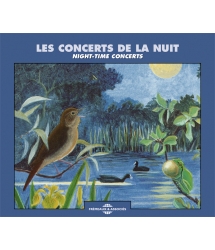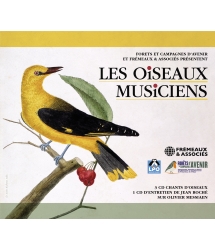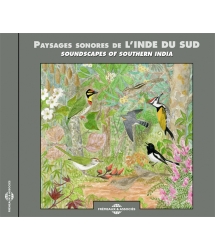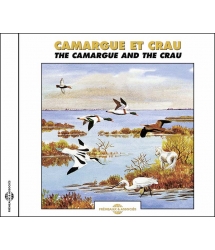- Our Catalog
- Philosophy
- Philosophers of the 20th century and today
- History of Philosophy (PUF)
- Counter-History and Brief Encyclopedia by Michel Onfray
- The philosophical work explained by Luc Ferry
- Ancient thought
- Thinkers of yesterday as seen by the philosophers of today
- Historical philosophical texts interpreted by great actors
- History
- Books (in French)
- Social science
- Historical words
- Audiobooks & Literature
- Our Catalog
- Jazz
- Blues
- Rock - Country - Cajun
- French song
- World music
- Africa
- France
- Québec / Canada
- Hawaï
- West Indies
- Caribbean
- Cuba & Afro-cubain
- Mexico
- South America
- Tango
- Brazil
- Tzigane / Gypsy
- Fado / Portugal
- Flamenco / Spain
- Yiddish / Israel
- China
- Tibet / Nepal
- Asia
- Indian Ocean / Madagascar
- Japan
- Indonesia
- Oceania
- India
- Bangladesh
- USSR / Communist songs
- World music / Miscellaneous
- Classical music
- Composers - Movie Soundtracks
- Sounds of nature
- Our Catalog
- Youth
- Philosophy
- News
- How to order ?
- Receive the catalog
- Manifesto
- Dictionnary











- Our Catalog
- Philosophy
- Philosophers of the 20th century and today
- History of Philosophy (PUF)
- Counter-History and Brief Encyclopedia by Michel Onfray
- The philosophical work explained by Luc Ferry
- Ancient thought
- Thinkers of yesterday as seen by the philosophers of today
- Historical philosophical texts interpreted by great actors
- History
- Books (in French)
- Social science
- Historical words
- Audiobooks & Literature
- Our Catalog
- Jazz
- Blues
- Rock - Country - Cajun
- French song
- World music
- Africa
- France
- Québec / Canada
- Hawaï
- West Indies
- Caribbean
- Cuba & Afro-cubain
- Mexico
- South America
- Tango
- Brazil
- Tzigane / Gypsy
- Fado / Portugal
- Flamenco / Spain
- Yiddish / Israel
- China
- Tibet / Nepal
- Asia
- Indian Ocean / Madagascar
- Japan
- Indonesia
- Oceania
- India
- Bangladesh
- USSR / Communist songs
- World music / Miscellaneous
- Classical music
- Composers - Movie Soundtracks
- Sounds of nature
- Our Catalog
- Youth
- Philosophy
- News
- How to order ?
- Receive the catalog
- Manifesto
- Dictionnary
A SELECTION OF COMMON BIRDS SONGS - 62 SPECIES
Ref.: FA658
EAN : 3448960265829
Artistic Direction : Patrick Frémeaux à partir de la sonothèque Jean Roché
Label : Frémeaux & Associés
Total duration of the pack : 50 minutes
Nbre. CD : 1
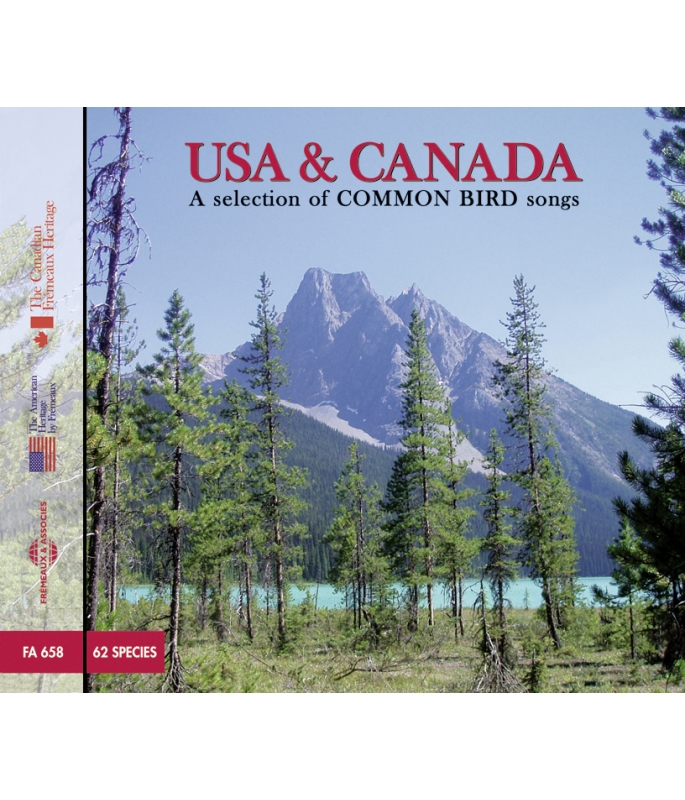
A SELECTION OF COMMON BIRDS SONGS - 62 SPECIES
A SELECTION OF COMMON BIRDS SONGS - 62 SPECIES
Frémeaux & Associés present, for the first time ever, under the direction of the well-knows bio acoustician ornithologist J.C. Roché, the first sound guide allowing the listener to recognise 62 species of common North-American continent birds from their voices. Songs and common calls are included for each species and described in a 16 pages English booklet. Patrick Frémeaux
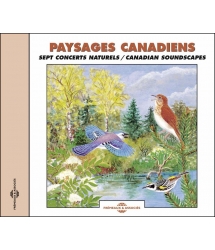
SEPT CONCERTS NATURELS
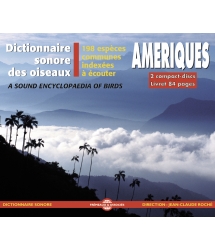
198 ESPECES INDEXEES A ECOUTER
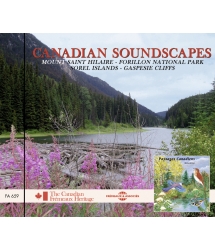
MOUNT SAINT-HILAIRE - FORILLON NATIONAL PARK - SOREL...



-
PisteTitleMain artistAutorDurationRegistered in
-
1Butor d'AmériqueAmerican bittern (Botaurus lentiginosus)00:00:402003
-
2Foulque d'AmériqueAmerican Coot (Fulica americana)00:00:372003
-
3Corneille d'AmériqueAmerican Crow (Corvus brachyrhynchos)00:00:352003
-
4Rougegorge AmèricainAmerican Robin (Turdus migatorius)00:01:072003
-
5Oriole de BaltimoreBaltimore oriole (Icterus galbula)00:00:422003
-
6Martin-pêcheur d'AmériqueBelted Kingfisher (Megaceryle alcyon)00:00:252003
-
7Coulicou à bec noirBlack-billed Cuckoo (Coccyzus erythropthalmus)00:00:332003
-
8Mésange à tête noireBlack-capped Chickadee (Parus atricapillus)00:00:402003
-
9Geai bleuBlue Jay (Cyanocitta cristata)00:00:552003
-
10Goglu des présBobolink (Dolichonyx oryzivorus)00:00:402003
-
11CailleBobwhite Quail (Colinus Virginianus)00:00:462003
-
12Moqueur rouxBrown Thrasher (Toxostoma rufum)00:01:342003
-
13Bernache du CanadaCanada goose (Branta canadensis)00:00:422003
-
14CardinalNorthern Cardinal (Cardinalis cardinalis)00:00:452003
-
15Troglodyte de CarolineCarolina wren (Thryothorus ludovicianus)00:00:502003
-
16Moqueur ChatGrey Catbird (Dumetella carolinensis)00:01:272003
-
17Paruline à flancs marronChestnut-sided Warbler (Dendroica pensylvanica)00:01:332003
-
18Râle grisClapper Rail (Rallus longirostris)00:00:422003
-
19Garrot à oeil d'orCommon Goldeneye (Bucephala clangula)00:00:382003
-
20Engoulevent d'AmériqueCommon Nighthawk (Chordeiles minor)00:00:312003
-
21Dickcissel d'AmériqueDickcissel (Spiza americana)00:00:312003
-
22Sturnelle des présEastern Meadowlark (Sturnella magna)00:00:402003
-
23Moucherolle phébiEastern phoebe (Sayornis phoebe)00:00:422003
-
24Tyran huppéGreat Crested Flycatcher (Myiarchus crinitus)00:00:292003
-
25Plongeon ImbrinGreat northern diver (Gavia immer)00:01:172003
-
26Plongeon ImbrinGreat northern diver (Gavia immer)00:01:172003
-
27Héron blancGreat white heron (Ardea Alba)00:00:242003
-
28Tyran grisGrey Kingbird (Tyrannus dominicensis)00:00:402003
-
29Grive solitaireHermit Thrush (Catharus guttatus)00:01:272003
-
30Troglodyte AedonHouse wren (Troglodytes aedon)00:00:412003
-
31Mouette atricilleLaughing Gull (Larus atricilla)00:00:532003
-
32Tourterelle tristeMourning Dove (Zenaida macroura)00:00:402003
-
33Moqueur polyglotteNorthern Mockingbird (Mimus polyglottos)00:01:342003
-
34Paruline couronnéeOvenbird (Seiurus aurocapillus)00:00:532003
-
35Grebe à bec bigarréPied billed grebe (Podilymbus podiceps)00:00:342003
-
36Grand PicPileated Woodpecker (Dryocopus pileatus)00:00:432003
-
37Paruline des présPrairie Warbler (Dendroica discolor)00:00:332003
-
38Paruline des présPrairie Warbler (Dendroica discolor)00:00:332003
-
39Pic à ventre rouxRed-bellied Woodpecker (Melanerpes carolinus)00:00:392003
-
40Viréo aux yeux rougesRed-eyed Vireo (Vireo olivaceus)00:00:462003
-
41Pic à tête rougeRed-headed Woodpecker (Melanerpes erythrocephalus)00:00:242003
-
42Carouge à épaulettesRed-winged Blackbird (Agelaius phoeniceus)00:00:522003
-
43Goéland à bec cercléRing-billed Gull (Larus delawarensis)00:00:302003
-
44Cardinal à poitrine roseRose-breasted Grosbeak (Pheucticus ludovicianus)00:00:582003
-
45Gélinotte huppéeRuffed Grouse (Bonasa umbellus)00:00:202003
-
46Tohi à flancs rouxRufous-sided Towhee (Pipilo erythrophtalmus)00:00:472003
-
47Grue du CanadaSandhill Crane (Grus canadensis)00:00:282003
-
48Geai BuissonnierScrub jay (Aphelocoma californica)00:00:332003
-
49Gelinotte à queue fineSharp tailed grouse (Tympanuchus phasianellus)00:00:472003
-
50Troglodyte à bec courtShort-billed marsh wren (Cistothorus platensis)00:00:372003
-
51Pinson à Gorge BlancheSong sparrow (Melospiza cinerea)00:00:582003
-
52Sora railSora rail (Porzana carolina)00:00:412003
-
53Chevalier griveléSpotted Sandpiper (Tringa macularia)00:01:012003
-
54Geai de StellerSteller's Jay (Cyanocitta stelleri)00:00:392003
-
55Grive à dos oliveSwainson's Thrush (Catharus ustulatus)00:01:302003
-
56Carouge de CalifornieTricolored Blackbird (Agelaius tricolor)00:00:412003
-
57Mésange bicoloreTufted Titmouse (Parus bicolor)00:00:432003
-
58Sittelle à poitrine blancheWhite-breasted Nuthatch (Sitta carolinensis)00:00:432003
-
59Viréo aux yeux blancsWhite-eyed Vireo (Vireo griseus)00:00:442003
-
60Bruant à gorge blancheWhite-throated sparrow (Zonotrichia albicollis)00:01:052003
-
61Grive des boisWood Thrush (Catharus mustelinus)00:01:112003
-
62Pic maculéYellow-bellied Sapsucker (Sphyrapicus varius)00:00:392003
-
63Carouge à tête jauneYellow-headed Blackbird (Xanthocephalus xanthocephalus)00:00:362003
-
64Paruline masquéeYellowthroat (Geothlypis trichas )00:00:402003
usa & Canada
usa & Canada
A selection of common bird songs (62 species)
1 - CD1 03 American Bittern – Botaurus lentiginosus
Found from Gulf of Mexico to Newfoundland, winters north to Virginia. Lives in areas of dense marsh. The bird is secretive and rarely seen. 65cm with overall brown body, striped underneath. Adults have a black neck mark and the wings have black tips (seen during flight). Has an unmistakable deep booming voice during the breeding season, which can be heard some distance away. Voice: adult booming
2 - CD1 15 American Coot – Fulica americana
Found in many regions of North America around ponds and lakes. Winters from the gulf of Mexico northwards Canada. 13-16cm with all black-grey plumage. The tail has a streak of white and the bill is white. The head and neck are generally darker than the body. On the forehead is a white and chestnut shield. The bird is a good swimmer and dives in deep water equally well. It`s voice consists of various chuckling, whining and clucking notes. Voice: adult calls and clucks
3 - CD1 11 American Crow – Corvus brachyrhynchos
Widespread throughout much of USA and Canada found mostly in open country and also in cities. 47cm with all black plumage and a strong bill. Voice is a harsh ‘cah’ or ‘caw’. Builds a large nest made from twigs. Voice: adult call
4 - CD1 32 American Robin – Turdus migratorius
A member of the Thrush family and found from Canada, south throughout the whole of the USA. Equally at home in parks, gardens, woodlands often seen hopping along the ground looking for worms. 25cm with a grey back and brick-red breast. Males have darker upperparts and tail and a yellow bill. White spots surround the eye. Voice is an unmistakable clear whistling made up of two to three note phrases – ‘shirrup cherio cheerup’. Builds a nest made from mud and grass. Often seen in large flocks during the winter. Voice: song of adult
5 - CD1 40 Baltimore Oriole – Icterus galbula
Found from Nova Scotia and Quebec south to Georgia and Texas, winters in central America. Breeds in groves. 18cm, an attractive bird with bright orange underparts and contrasting dark brown head. Upperparts are dark brownblack with white barring on the wings and yellow scapulars. Females are paler brown above with paler orange-buff underparts. Usually seen singly or in pairs. Song is a series of rich whistled phrases while the call is a dry chattering. Builds a tightly woven nest made from plant fibres that hangs from the branches of a tree. Voice: adult song and calls
6 - CD1 31 Belted Kingfisher – Megaceryle alcyon
Fairly common throughout the USA and Canada, wintering south to Florida and Texas. 27-34cm, blue-grey above with a blue grey bib. The belly and lower part of the breast is white. Females have a rusty red chest band. The large head is greyblue with a high crest and the throat is white. The dark grey bill is long and powerful enabling the bird to capture fish. The tail is short and banded with black. Identified during flight by its uneven wing beats. Voice is a loud harsh rattling. Voice: adult calls
7 - CD1 12 Black-billed Cuckoo – Coccyzus erythropthalmus
Breeds from Quebec and South Edward Island south to North Carolina. Winters in South America. A secretive slender long tailed bird primarily feeding on insects and living mainly in woodlands. 28-30cm with light brown upperparts and white underparts. The tail is grey with narrow white spots and the bill is black. Adults have a red eye-ring. The bird sometimes sings at night and the voice is a quick ‘cu cu cu, cucucu, cucucu, cucucu……’ or a series of fast repeated ‘kuks’. Voice: adult song
8 - CD1 33 Black-capped Chickadee – Parus atricapillus
Common throughout most of the USA and Canada, preferring to live in wooded areas where it can often be seen in flocks during the winter. Also regular garden visitors. 13cm, the belly and breast are buff yellow while the upperparts are mostly grey with some white in the wing. Cheeks are white and has black cap and bib. A very active acrobatic bird often hanging upside down as it searches for insects. Calls are a high-pitched ‘chick-a-dee-dee’ and the song consists of a clear ‘fee-bee, fee-bee’. Typically nests in tree holes. Voice: adult song
9 - CD1 18 Blue Jay – Cyanocitta cristata
Common all year round in most central and eastern states of America and lower parts of Canada. Prefers to live in parks, woods and gardens. One of the more colourful members of the crow family, 27cm with mostly blue upperparts and whitish below. The tail and wings are brighter blue with black barring. The paler head has a crest, thin black eye stripe and black necklace. The bird is often noisy and utters a harsh rasping ‘jeeah’ and sometimes more musical ‘beadle-beadle’ phrases. Voice: adult song
10 - CD 1 22 Bobolink – Dolichonyx oryzivorus
Range covers from south Quebec to New Jersey, Illinois and Missouri USA. Winters in South America. Typically found in meadows and hayfields. A member of the blackbird family. A medium sized bird (18cm), males have dark plumage with white patches on the shoulders and a flesh coloured nape during spring and summer. In late summer the male moults and transforms his plumage to that resembling the female – buff-golden body streaked with brown and black stripes on the head similar to an American house sparrow. Song is a thin fluty jumble of notes often given on the wing. Also produces a ‘pink’ call during flight. Voice: adult song
11 - CD1 10 Bobwhite – Colinus virginianus
Belongs to the Quail family and is found chiefly in areas of agriculture from Gulf of Mexico to South Dakota, South Minnesota and southern Ontario. 21-25cm, the body is mostly reddish brown speckled with white and the tail very short. Males have a white throat and black eyebrow while females have buff throat and brown eyebrow. Voice is a repeated whistled ‘bob….white’ while calls are a shrill ‘kaloi- kee’. Voice: adult song
12 - CD1 37 Brown Thrasher – Toxostomarufum
Found throughout eastern and central states of America and parts of Quebec typically in thickets and shrubbery. 26-28cm, a slim long tailed bird with brown upperparts and long brown tail. Underparts are buff-white speckled with dark brown spots. The eye is golden and has grey-black wing bars. The song is made up of a succession of musical notes and short phrases (often phrases sang in pairs). Call is a harsh sudden ‘chak’. Builds an open cup shaped nest. Voice: adult song
13 - CD1 01 Canada Goose – Branta canadensis
Common bird breeding from the Arctic Coast south to Dakota and Gulf of St. Lawrence. Winters from Great Lakes south to Gulf of Mexico. Frequents ponds, lakes, parks, reservoirs and other areas of fresh water. 90-100cm with brown barred upperparts, white rump and white with a black terminal band. The head has a white chin strap. Has a deep honking repetitive voice. Voice: adult call
14 - CD1 05 Cardinal – Cardinalis cardinalis
Common in most eastern states of America and parts of the southwest. Frequents forests, swamps, deserts and parks. 22cm males are bright red with a black patch at the base of the bill. Females are a duller yellowish brown. Both sexes have a crest on the head and large powerful pink bills used to crack open seeds. Song consists of a series of slurred whistles typically diminishing in pitch – ‘cheer… cheer…cheer….cheer’. The call is a short thin ‘chip’. Voice: adult song
15 - CD1 57 Carolina Wren – Thryothorus ludovicianus
Common through the eastern half of the U.S. and Mexico. 14cm, chestnut brown upperparts with a bold white eyebrow. Underparts are buff butterscotch. Song is a rolling ‘liberty-liberty-liberty-whew’ with a wide variety of variations. Voice: adult song
16 - CD1 35 Catbird – Dumetella carolinensis
Breeds from Nova Scotia to north Florida and southeast Texas. Winters in southern United States. Lives in thickets where it forages seeking insects or eating berries. A slim, long-tailed bird 21cm and mostly grey in colour with a brick-red vent and black cap. Voice is an odd series of squeaky and whining notes, calls are a cat like ‘meyew’. Builds a well-hidden cup shaped nest. Voice: adult song
17 - CD1 41 Chestnut-sided Warbler – Dendroica pensylvanica
Range covers Manitoba and Gulf of St. Lawrence, south to Nebraska, Ohio and Tennessee. Winters in Central America. Breeds in second-growth woodlands and 12cm with a yellow crown, black face stripe and white cheeks. Wings have two yellow bars and the tail is greyblack. During autumn the olive-grey upperparts turn a lime green and the eye surrounded by a prominent white ring. Males have chestnut sides during spring. Voice is a characteristic ‘please please please ta meeetcha’ while a more rambling song is given during the summer. Voice: adult song
18 - CD1 50 Clapper Rail – Rallus longirostris
Found on salt marshes along the Atlantic coast and Gulf coast north to Connecticut. Much more scarce in western USA. 37cm with a long thin bill. Overall mostly grey plumage with white patch under the short tail. Rales are plump, secretive, chicken like birds that are more often heard than seen. The voice is a clattering ‘kek-kek-kek-kek’. Voice: adult calls
19 - CD1 16 Common Goldeneye – Bucephala clangula
Range covers Hudson Bay and north Labrador south to Dakota and New York. Winters to South Carolina and the Gulf Coast. Found as much on freshwater lakes as it is on the sea. 40-48cm, both sexes have a steep forehead and a piercing yellow-golden eye. The male has a glossy green head with a white patch between the bill and eye. Upperparts are black and underparts and flanks are a contrasting white. The female has a brown head, white neckband and grey body. The duck is usually silent except during courtship. Voice: adult calls
20 - CD1 14 Common Nighthawk – Chordeiles minor
Found throughout nearly the whole of the USA and Canada, common on farmland, open woods and cities. 22-23cm with highly mottled grey plumage and heavily barred pale underparts. Recognisable from other nighthawks by a broad white wing patch. Nighthawks are nocturnal birds, resting on low tree branches during the day. Its mottled brown plumage offers superb camouflage. Usually calls a buzzy, nasal ‘pzeeeent’ during flight. Nests on bare ground. Voice: adult flight call
21 - CD1 13 Dickcissel – Spiza americana
Breeds in the prairie states (Michigan, Ohio, Texas, Alabama) of the USA and winters in South America. A relation of the sparrow. 15-17cm, males have a yellow breast and black bib with orange-brown upperparts streaked with black. The belly is light grey and supercilium is yellow. Females lack the yellow and look similar to a House Sparrow. The birds’ song is a rendition of its name – ‘dickciss-ciss-ciss’ and the flight call is a sharp ‘bzznt’. Voice: adult song
22 - CD1 52 Eastern Meadowlark – Sturnella magna
Widespread in eastern and southwestern USA, breeding in meadows and prairies. Belongs to the blackbird family. 24cm with a bright yellow breast crossed with a black V. Upperparts are brown with dark brown streaking. Song consists of clear slurred whistles ‘te-seyeer seeyaayay’ while calls are buzzy and drier. Voice: adult song
23 - CD1 38 Eastern Phoebe – Sayornis phoebe
Breeds from Nova Scotia and Quebec south to Texas and the mountains of Georgia. Winters throughout southern USA. Lives along the banks of streams where it often builds a mud nest under bridges. 17cm with plain grey-brown upperparts and off-white underside. The head is browner in colour and juveniles are darker brown overall. Members of the flycatcher family, these birds are identified by their tail wagging habit. Voice is a soft ‘phoe-be’ with the pitch of the second note often alternating higher and lower. Call is a quick ‘peep’. Voice: adult song
24 - CD1 60 Great Crested Flycatcher – Myarchus crinitus
Breeds throughout most of central and eastern USA and southern parts of Canada in forested areas. 24cm with a bushy head, grey throat and breast and yellow belly. The long tail is rufous brown. Voice is a loud ‘wheeeeep’ whistle and a throaty, trilled ‘prrrrrreet’. Nests in tree holes. Voice: adult song
25 - CD1 49 Great Northern Diver (Common Loon) – Gavia immer
Breeds on lakes across Canada and northern edge of USA. Migrates and west coasts of North America. 80cm with a long browngrey body and brown-grey head. The throat, breast and sides of the head are white. The bird is sometimes seen swimming with only the head and neck above water. During summer the head is glossy black with a white collar and the back is chequered with black and white. The usual light grey bill also turns jet black. The call is an unmistakable haunting yodelling mixed with unsteady laughter. Voice: adult calls
26 - CD1 23 Great White Heron – Casmerodius albus
A distinct race of Great Blue Heron found only in Florida, USA. 117cm, this is the largest American Heron, with greenish-yellow long legs and all white plumage. Often seen standing patiently at the waters edge where it uses its long bill to spear fish, the birds main source of food. Nests in scattered groups in dense mangrove undergrowth. Voice consists of sudden low grunts and barks. Voice: calls of adults
27 - CD1 59 Grey Kingbird – Tyrannus dominicensis
Found mainly around the coasts of Florida USA and widespread in the Caribbean. 22-23cm with pale grey upperparts and whitish underparts. Ear coverts are a darker grey and the wings have some brown in them. The tail is notched at the tip and the bill is thick and black. Often seen calling perched in the open. Can be aggressive towards other birds. Voice is a loud ‘pi-teer-rrry’ interspersed with variations. Voice: adult song
28 - CD1 28 Hermit Thrush – Catharus guttatus
Occurs throughout much of Canada and western states of America migrating through central parts of America during spring and autumn. Winters throughout southern USA. Prefers mixed evergreen forests. 18cm with mostly greybrown plumage. The cream breast is spotted with brown and the short tail is reddish in colour. Song consists of clear fluty phrases sang at different pitches, each usually introduced by a prominent clear note and sang after a short pause. Calls include a scolding ‘tuk-tuk…..’. Often seen cocking its tail. Voice: adult song
29 - CD1 58 House Wren – Troglodytes aedon
Commonly found throughout nearly all of North America in woodlands, farmyards and gardens. 12cm with mostly plain brown plumage. A very active bird often seen holding its tail straight up. The bill is very thin and a thin eye-ring surrounds the eye. The wings and tail have some dark barring. Voice is a stuttering jumbled series of notes that rise to a musical burst and then fall at the end. Voice: adult song
30 - CD1 39 Laughing Gull – Larus atricilla
Found on southern Atlantic and Gulf coasts breeding in colonies on salt marshes and grassy islands from Nova Scotia to Texas. 40cm, adults have dark grey back fading into black wingtips. The head is black during the breeding season, fading to white at other times of the year. The bill and legs are dark and usually tinged with red. Immatures have scaly brown plumage. Voice is a far carrying laugh ‘ha-ha-ha-ha-ha-ha’. Voice: calls of a colony
31 - CD1 55 Mourning Dove – Zenaida macroura
Common throughout the USA and much of Canada in wooded areas. 30cm, with a pointed tail that shows white spots during flight. Body colour is mostly plain grey with black spots on the head and are more pinkish on the breast and belly. Females are generally duller and browner in colour. The voice is a slow mournful ‘cooowah, coooo, cooo, cooooo’. Voice: adult song
32 - CD1 36 Northern Mockingbird – Mimus polyglottos
Lives in warmer southern states of America in cities, farms, desert areas and woodlands. A relation of the Catbird and measuring 26cm, the northern mockingbird is slim with a long tail and is mostly pale grey with white wing patches. The outer tail feathers are white and young birds have dark streaks on the belly. Eats mostly insects and many berries. Often sings for long periods (sometimes all night) constantly repeating short phrases and then suddenly switching to a different phrase. The song often includes avian mimicry. Calls consist of a nasal ‘ssseeee’. Voice: adult song and calls
33 - CD1 42 Ovenbird – Seiurus aurocapillus
Breeds in north eastern states of America and across southern parts of Canada. Migrates to Florida and into the tropics during the winter. Found in wooded areas and measuring approx. 15cm with a thrush like appearance. Upperparts are olive-brown while underparts are white striped with black. The head has a dull orange stripe bordered with black and the eye is surrounded with a bold white eye-ring. Song is a loud rapidly repeated ‘teach-er – teach-er – teacher’ which becomes louder on each repeat. Voice: adult song
34 - CD1 25 Pied-billed Grebe – Podylimbius podiceps
The most wide spread Grebe in America found on ponds, marshes and lakes except in the very far north. 33cm very aquatic, sometimes preferring to swim with just its head out of the water. Overall body colour is brown, the bill is white with a black ring during the breeding season while at other times it is plain and dull. The throat also has a black patch during breeding. Voice consists of a an unusual gobbling ‘kum-kum-kum-kum, kum-kowp’. Voice: adult call
35 - CD1 24 Pileated Woodpecker – Dryocopus pileatus
One of North Americas largest woodpeckers found from Nova Scotia and Manitoba south to Florida and the Gulf of Mexico. Lives in woodlands where it digs large oblong holes in trees. 43-47cm with mostly black body and white underwings. The crown is red and crested and the neck and face are striped black and white. Males have a red moustache. Voice is a loud wild sounding series of notes ‘kuk….. kuk-…. kuk….. kukkuk…….’ Voice: adult drumming
36 - CD1 43 Prairie Warbler – Dendroica discolor
Resident all year from Florida north to Massachusetts and New York USA. 12cm, with yellow underparts and olive upperparts. The male is brighter than the female and both have two dull wing bars. The face has some black patterning and in close observation chestnut markings can be seen on the males back. Spends most of its time flitting around in thickets close to the ground constantly bobbing its tail. Voice is a thin ‘zee zee zee zee zee zee zee’ which ascends the chromatic musical scale. Voice: adult song
37 - CD1 46 Red-bellied Woodpecker – Melanerpes carolinus
Resident throughout most central and eastern states of North America from Florida to Delaware. A noisy bird found in many habitats including forests, swamps, suburbs and parks. The back is barred thinly with black and white, underparts and face are buff-brown. The nape and lore are red (females have less red in the plumage). The red on the belly is very faint. Voice is a loud repeated ‘chur’ or ‘chaw’. Voice: adult call
38 - CD1 62 Red-eyed Vireo – Vireo olivaceus
Common throughout most of Canada and the USA, winters in South America. Breeds in woodlands, more often heard rather than seen. 15cm with olive-green upperparts and white below. Above the red eye is a white stripe and the head has some black patterning. Song is a series of short whistled phrases, which are separated by pauses and repeated many times. Voice: adult song
39 - CD1 45 Red-headed Woodpecker – Melanerpes erythrocephalus
Fairly common throughout most of the USA in wooded areas, orchards and open country. 23cm with a bright red head, black tail and large pale brown beak. Underparts are white and upperparts mostly black with white wing patches. Young birds have brown head and upperparts. Excavates its own nest hole in trees and eats mainly nuts. Voice is a loud ‘queeoh’. Voice: adult call
40 - CD1 06 Red-winged Blackbird – Agelaius phoeniceus
Common throughout most of North America and Canada in areas of marsh, farmland, and forest edges. 22cm males have all black plumage and bright red shoulder patches (displayed while singing in the breeding season) usually bordered with yellow. Females and young are streaky brown with buff supercilium. Song is a nasal gurgling ‘konk-lareee’ with the last note high. Call is a dry ‘chakk’. Voice: adult song and calls
41 - CD 1 21 Ring-billed Gull – Larus delawarensis
Very common and breeding from Gulf of St. Lawrence south to Dakota, migrates throughout USA to Gulf of Mexico, wintering in New England. Large flocks are often seen on ponds, beaches and rivers. 45-50cm, adults have white underparts and white heads. Wings and mantle are grey and the bill is yellow with a black ring. The tips of the wings are black spotted with white and the legs are yellowy-green. Immature birds are much paler and greyer in colour and don’t attain adult plumage until their third year. Voice is a loud ‘kee-oww’ mixed with squealing notes. Voice: calls of adults
42 - CD1 04 Rose-breasted grosbeak – Pheucticus ludovicianus
Breeds from Ontario and Quebec south to Kansas and central Ohio USA. Winters south to central and South America. 19cm, males are black and white with a red triangular patch on the breast. Females are streaked like a sparrow. The beak is very large and powerful. Has a mellow musical robin like song and metallic sharp ‘eek’ call. Voice: adult song
43 -CD 1 20 Ruffed Grouse – Bonasa umbellus
Occurring from Canada to New Jersey and Alabama in the U.S.A., sometimes as far south as Ohio. Lives in woodlands. 16-19cm with reddy-grey brown plumage. The tail is fan shaped and has a black band at the tip. Two different colour variations do occur; grey birds with grey tails and red birds with rufous on the tail. During breeding the male thumps his wings while strutting with the tail spread and dark neck ruffs puffed up. As the thumping gains speed it sounds reminiscent to a motor starting. The bird spends most of its time on the ground. Voice: male feather thumping
44 - CD1 54 Rufous-sided Towhee – Pipilo erythropthalmus
Found from Ontario to Gulf Coast and Florida USA, winters in Texas and Okalahoma. Frequents woodlands and bushy places feeding on the ground amongst leaf litter. 20cm, males have mostly black upperparts and throat, rusty sides and black head. The belly has a white stripe. Females are brown above with lighter orange-brown near the base of the tail. Eyes are usually red but a white-eyed form occurs in Florida. Voice is two short notes followed by a trill ‘drinkyour-teeeeee’ with the last part being higher. Call is a sharp ‘chewink’. Voice: adult song
45 - CD1 29 Sandhill Crane – Grus Canadensis
Breeds from the prairies of Canada, migrates as far south as Florida and Texas. Nests around marshes but often seen feeding around areas of cultivation. Unlike Herons, Cranes fly with their necks outstretched and generally the bill is shorter. Standing tall (105cm) this bird has a grey body and long grey neck with some brown-red staining sometimes on body feathers. The lower half of the head is white while the upper head is red. Voice is a deep, trumpeting ‘k-r-r-r-rooo’ often heard during flight. Voice: adult calls
46 - CD1 17 Scrub-Jay – Aphelocoma coerulescens
Found only in Florida, USA amongst scrub oak habitats. 29cm, upperparts, wings and tail are solid blue and the mantle is olive-brown. Underparts are white and a blue necklace separates the white throat from the breast. The Scrub Jay is now a threatened species due to loss of habitat. Voice is a thin rasping ‘kweah…..kweah’ and low rasping ‘shrrreck’. Voice: adult calls
47 - CD1 53 Sharp-tailed Grouse – Tympanuchus phasianellus
Found from Quebec and Manitoba to Wisconsin and central parts of Nebraska. Frequents prairies and areas of scattered trees. 44cm, brown upperparts with white dappling. Underparts are mostly white and spotted. The tail is pointed and appears white during flight. During breeding the male dances to attract females, strutting with the tail held vertical while making soft cooing sounds. Voice is a muffled mew followed by a sudden high-pitched yelp. Voice: song of adult male
48 - CD1 56 Short-billed Marsh Wren – Cistothorus platensis
Found from Ontario south to Delaware, Missouri and east Kansas USA, living in damp meadows and grassy marshes. Winters from New Jersey to Gulf of Mexico. 11cm with mostly buff-brown plumage with narrow streaks on the back. Has a short bill and white line over the eye. Voice includes a staccato chatter – ‘chap chap chap chap…..’ and repetitive ‘sybian… sybian… sybian… sybian’ phrases. Usually nests in tree holes. Voice: adult call
49 - CD1 02 Song Sparrow – Melospiza melodia
Found throughout most of USA, less common in the far north. Frequents gardens and parks. 12-13cm, plumage colour varies by region – paler in desert areas and darker in northwest - mostly light brown and heavily streaked. The tail is long and song can be variable, consisting of sweet musical phrases often repeated. Voice: adult song
50 - CD1 30 Sora Rail – Porzana Carolina
Widespread throughout USA and Canada wintering south in Florida and Texas. A chicken-like bird found in marshes and hidden amongst reeds. 22cm, the body is mostly brown and the breast and belly grey. The bill is short and stumpy and the legs creamy-yellow. Adults have a black face, brown crown and bright yellow and black bill. Younger birds have a lighter greyer breast and duller bill and more white in their plumage overall. The bird is often seen flicking its short tail when nervous. Often its clear whistling ‘surrrrrreeeee’ call is heard while the bird is hidden from sight. Voice: adult song
51 - CD1 09 Spotted Sandpiper – Tringa macularia
Found throughout USA and most of Canada on lakes and around streams. 17-18cm, olive-brown upperparts with creamy-white underparts that are spotted during the Spring. The yellowy-orange legs are long and during spring the bill is orange tipped with black. Belonging to the family of smallest shorebirds these birds are often seen bobbing their tails and heads up and down. Voice is a well-pronounced ‘peeet-weeet’. Voice: adult song
52 - CD 1 19 Steller’s Jay – Cyanocitta stelleri
Resident in western parts of USA and Canada in forests, mountainous areas and along the coast. 29cm with a mostly dark grey upper body and dull blue underparts. The head has a crest and is darker grey-black with a faint white spots. The lower parts of the wings are blue with black barring and the tail is also blue. Two forms exist, the coastal form being generally brighter in colour with blue spots on the head instead of white. Voice is a harsh ‘kesssh’ phrase or fast ‘shek-shek-shek’. Also utters many other jay like screams and barks. Voice: adult calls
53 - CD1 26 Swainson’s Thrush – Catharus ustulatus
A familiar migrant during the spring and early autumn throughout most of the USA, but most commonly found in north and western parts of Canada and USA living in forests. 17cm with brown upperparts and buff eye-ring. Belly and breast are buff with brown spots. Winters in the tropics. Voice consists of a short well-pronounced note ending with unusual shorter higher pitched phrases. Call is a soft ‘hwwoit’ Voice: adult song
54 - CD1 08 Tricoloured Blackbird – Agelaius tricolor
Normally only found in parts of California and usually seen in dense flocks. 23cm with all black plumage. Males have a deep red shoulder patch with a white border. Females and young are very similar to the Red-winged Blackbird but generally darker in colour. Voice is a high-pitched sudden burst of jumbled notes. Voice: adult song
55 - CD1 34 Tufted Titmouse – Parus bicolour
Mostly found in southern parts of USA but more recently expanded its range further north. Frequents forests and parks often high in the treetops and usually seen in pairs or small flocks. 16cm, mostly grey body with paler face and underparts. The forehead is black and the sides are tinged rusty red. This bird has a tufted grey crest and a black crested form exists in parts of Texas. Belongs to the same family as the Chickadees. Voice is a clear whistled repetitive ‘peter, peter’ or ‘peeto, peeto’. Calls are varied and include wheezy ‘sesee-nyahh’. Voice: adult song
56 - CD1 51 White-breasted Nuthatch – Sitta carolinensis
Resident from Quebec south to Florida USA and found in woodlands, parks and orchards. 11cm, a small tree climbing bird with a short tail and long bill. Upperparts are grey, crown is darker grey. Underparts are white with some orange-brown on the lower belly. Voice is a low, thin slow ‘yaaank..yaaank’ also abrupt nasal ‘tootoo’. Nests in tree holes. Voice: adult song and calls
57 - CD1 61 White-eyed vireo – Vireo griseus
Breeds from Florida and Gulf of Mexico north to New York, Ohio and Wisconsin USA. Occupies areas of dense shrubbery. 12-13cm, olive-grey upperparts and whitish below with two white bars on the wings. The sides have a yellow tinge, as does the head around the eyes. Juveniles have darker grey sides. The eyes are a piercing white with dark pupils. Voice is a persistent jumble of notes ‘chick-a-perooo-chick’. Eats mostly insects. Voice: adult song
58 - CD1 48 White-throated Sparrow – Zonotrichia albicollis
Range covers Quebec and Newfoundland, south to Ontario, New England and Pennsylvania. Winters south to Gulf of Mexico. Often seen in large flocks in parks, gardens and woodlands. 16cm with a grey breast and white throat. Has a yellow spot between the dark bill and eye. Adults have two colour morphs - white-striped birds and tan-striped birds. Voice is a series of clear whistles, the call is a hard ‘chink’. Voice: adult song
59 - CD1 27 Wood Thrush – Catharus mustelinus
Lives in woodlands throughout eastern parts of the USA including New Hampshire, Minnesota and South Dakota almost to Gulf of Mexico. Winters from Florida. 20cm with brown upperparts and bold eye-ring. Underparts are white and heavily spotted with dark brown. The head has faint red shading and the tail is rather short. Most commonly seen foraging on the ground. Song includes variable musical phrases, mostly a fluty ‘ee-o-lay’ often interspersed with guttural notes. Call is a fast repetitive ‘pip’. Voice: adult song
60 - CD1 47 Yellow-bellied Sapsucker – Sphyrapicus varius
Breeds from south Quebec to New England, north Ohio and Missouri. Winters from Gulf of Mexico to Wisconsin USA. Sapsuckers drill rows of sap wells in the bark of trees and then later return to drink the oozing sap. 21cm with a black back mottled with white and some pale yellow. The male has a red throat and the females’ throat is white. The wing has a long bold white stripe and the neck and head are striped black and white. Both sexes have a red cap. Voice is a jay like mewing slurring downwards and the drumming consists of several staccato thumps followed by several slower thumps. Voice: adult drumming
61 -CD1 07 Yellow-headed Blackbird – Xanthocephalus xanthocephalus
Breeds around marshes from Canada south to Wisconsin and Indiana U.S.A. 9-11cm, with black body and wings (a white patch can be seen in the wing during flight). The head is yellow and the bill is grey. Females are more brown with brown on the crown and yellow confined more to the throat and chest. Song comprises of throaty rasping notes and its call is a low-pitched ‘krik’. Often seen in flocks outside the nesting season on farm fields and prairies. Voice: adult song
62 - CD1 44 Yellowthroat – Geothlypis trichas
Breeds from Canada south to Florida and is the only warbler in northern America that nests in open marshes. Also found in thickets and damp woodlands. 13cm, males have bright yellow breast and a black masked face. The black is bordered above with white and the upperparts are olivebrown. Females are plain olive-brown with a yellow throat, buff yellow breast and white belly. Females lack the black mask. Song is a quick bright ‘witchy-witchy-witchy-witchy’ while calls are a throaty ‘tchuck’. Voice: adult song
Andrew FISHER
© 2005-2008 FRÉMEAUX & ASSOCIÉS
01 - American Bittern – Botaurus lentiginosus
02 - American Coot – Fulica americana
03 - American Crow – Corvus brachyrhynchos
04 - American Robin – Turdus migratorius
05 - Baltimore Oriole – Icterus galbula
06 - Belted Kingfisher – Megaceryle alcyon
07 - Black-billed Cuckoo – Coccyzus erythropthalmus
08 - Black-capped Chickadee – Parus atricapillus
09 - Blue Jay – Cyanocitta cristata
10 - Bobolink – Dolichonyx oryzivorus
11 - Bobwhite – Colinus virginianus
12 - Brown Thrasher – Toxostomarufum
13 - Canada Goose – Branta canadensis
14 - Cardinal – Cardinalis cardinalis
15 - Carolina Wren – Thryothorus ludovicianus
16 - Catbird – Dumetella carolinensis
17 - Chestnut-sided Warbler – Dendroica pensylvanica
18 - Clapper Rail – Rallus longirostris
19 - Common Goldeneye – Bucephala clangula
20 - Common Nighthawk – Chordeiles minor
21 - Dickcissel – Spiza americana
22 - Eastern Meadowlark – Sturnella magna
23 - Eastern Phoebe – Sayornis phoebe
24 - Great Crested Flycatcher – Myarchus crinitus
25 - Great Northern Diver (Common Loon) – Gavia immer
26 - Great White Heron – Casmerodius albus
27 - Grey Kingbird – Tyrannus dominicensis
28 - Hermit Thrush – Catharus guttatus
29 - House Wren – Troglodytes aedon
30 - Laughing Gull – Larus atricilla
31 - Mourning Dove – Zenaida macroura
32 - Northern Mockingbird – Mimus polyglottos
33 - Ovenbird – Seiurus aurocapillus
34 - Pied-billed Grebe – Podylimbius podiceps
35 - Pileated Woodpecker – Dryocopus pileatus
36 - Prairie Warbler – Dendroica discolor
37 - Red-bellied Woodpecker – Melanerpes carolinus
38 - Red-eyed Vireo – Vireo olivaceus
39 - Red-headed Woodpecker – Melanerpes erythrocephalus
40 - Red-winged Blackbird – Agelaius phoeniceus
41 - Ring-billed Gull – Larus delawarensis
42 - Rose-breasted grosbeak – Pheucticus ludovicianus
43 - Ruffed Grouse – Bonasa umbellus
44 - Rufous-sided Towhee – Pipilo erythropthalmus
45 - Sandhill Crane – Grus Canadensis
46 - Scrub-Jay – Aphelocoma coerulescens
47 - Sharp-tailed Grouse – Tympanuchus phasianellus
48 - Short-billed Marsh Wren – Cistothorus platensis
49 - Song Sparrow – Melospiza melodia
50 - Sora Rail – Porzana Carolina
51 - Spotted Sandpiper – Tringa macularia
52 - Steller’s Jay – Cyanocitta stelleri
53 - Swainson’s Thrush – Catharus ustulatus
54 - Tricoloured Blackbird – Agelaius tricolor
55 - Tufted Titmouse – Parus bicolour
56 - White-breasted Nuthatch – Sitta carolinensis
57 - White-eyed vireo – Vireo griseus
58 - White-throated Sparrow – Zonotrichia albicollis
59 - Wood Thrush – Catharus mustelinus
60 - Yellow-bellied Sapsucker – Sphyrapicus varius
61 - Yellow-headed Blackbird – Xanthocephalus xanthocephalus
62 - Yellowthroat – Geothlypis trichas
CD USA & Canada © Frémeaux & Associés. Droits audio : Frémeaux & Associés - La Librairie Sonore (Producteur initial : Sittelle, Pithys, Collection Allain Bougrain Dubourg ou Ceba) / Ecouter les chants d'oiseaux sur CD : Sons et ambiances naturelles des écosystèmes - Stéreo and digital recording of the natural landscape sound. Natural sound sceneries of écosystems, Voices of the Wild Life. Les droits de cet enregistrement sont protégés par la loi. Pour toute exploitation d’illustration sonore sur CD, DVD, CD-Rom, Télévision, Cinéma, Sites internet, scénographies (théâtre, musées…), l’autorisation et un devis gratuit peuvent être obtenus auprès de Frémeaux & Associés – fax : +33 (0)1 43.65.24.22 info@fremeaux.com
